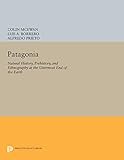Patagonia : Natural History, Prehistory, and Ethnography at the Uttermost End of the Earth / ed. by Colin McEwan, Alfredo Prieto, Luis A. Borrero.
Material type: TextSeries: Princeton Legacy Library ; 386Publisher: Princeton, NJ : Princeton University Press, [2014]Copyright date: ©1998Edition: Course BookDescription: 1 online resource (206 p.) : 7 color photos 100 duotones 11 mapsContent type:
TextSeries: Princeton Legacy Library ; 386Publisher: Princeton, NJ : Princeton University Press, [2014]Copyright date: ©1998Edition: Course BookDescription: 1 online resource (206 p.) : 7 color photos 100 duotones 11 mapsContent type: - 9780691601625
- 9781400864768
- Indians of South America -- Patagonia (Argentina and Chile)
- Indians of South America -- Patagonia (Argentina and Chile);Natural history -- Patagonia (Argentina and Chile);Patagonia (Argentina and Chile) -- Description and travel
- Natural history -- Patagonia (Argentina and Chile)
- Patagonia (Argentina and Chile) -- Description and travel
- SOCIAL SCIENCE / Anthropology / General
- 918.29
- F2936 -- P3157 1997eb
- online - DeGruyter
- Issued also in print.
| Item type | Current library | Call number | URL | Status | Notes | Barcode | |
|---|---|---|---|---|---|---|---|
 eBook
eBook
|
Biblioteca "Angelicum" Pont. Univ. S.Tommaso d'Aquino Nuvola online | online - DeGruyter (Browse shelf(Opens below)) | Online access | Not for loan (Accesso limitato) | Accesso per gli utenti autorizzati / Access for authorized users | (dgr)9781400864768 |
Frontmatter -- Contents -- Foreword by the Ambassadors of Argentina and Chile to the United Kingdom -- Introduction -- THE CONTRIBUTORS -- ACKNOWLEDGEMENTS -- KEY DATES AND EVENTS -- 1. The Natural Setting The Glacial and Post-Glacial Environmental History of Fuego-Patagonia -- 2. The Peopling of Patagonia The First Human Occupation -- 3. Middle to Late Holocene Adaptations in Patagonia -- 4. The Origins of Ethnographic Subsistence Patterns in Fuego-Patagonia -- 5. The Great Ceremonies of the Selk'nam and the Yamana -- 6. The Meeting of Two Cultures Indians and Colonists in the Magellan Region -- 7. The Patagonian 'Giants' -- 8. Travelling the Other Way Travel Narratives and Truth Claims -- 9. Tierra del Fuego - Land of Fire, Land of Mimicry -- 10. Patagonian Painted Cloaks -- BIBLIOGRAPHY -- INDEX -- PICTURE ACKNOWLEDGEMENTS
restricted access online access with authorization star
http://purl.org/coar/access_right/c_16ec
Some fourteen to ten thousand years ago, as ice-caps shrank and glaciers retreated, the first bands of hunter-gatherers began to colonize the continental extremity of South America--"the uttermost end of the earth." Their arrival marked the culmination of humankind's epic journey to people the globe. Now they are extinct. This book tells their story.The book describes how these intrepid nomads confronted a hostile climate every bit as forbidding as ice-age Europe as they penetrated and settled the wilds of Fuego-Patagonia. Much later, sixteenth-century European voyagers encountered their descendants: the Aünikenk (southern Tehuelche), Selk'nam (Ona), Yámana (Yahgan), and Kawashekar (Alacaluf), living, as the Europeans saw it, in a state of savagery. The first contacts led to tales of a race of giants and, ever since, Patagonia has exerted a special hold on the European imagination. Tragically, by the mid-twentieth century, the last remnants of the indigenous way of life had disappeared for ever. The essays in this volume trace a largely unwritten history of human adaptation, survival, and eventual extinction. Accompanied by 110 striking photographs, they are published to accompany a major exhibition on Fuego-Patagonia at the Museum of Mankind, London.The contributors are Gillian Beer, Luis Alberto Borrero, Anne Chapman, Chalmers M. Clapperton, Andrew P. Currant, Jean-Paul Duviols, Mateo Martinic B., Robert D. McCulloch, Colin McEwan, Francisco Mena L., Alfredo Prieto, Jorge Rabassa, and Michael Taussig.Originally published in 1998.The Princeton Legacy Library uses the latest print-on-demand technology to again make available previously out-of-print books from the distinguished backlist of Princeton University Press. These editions preserve the original texts of these important books while presenting them in durable paperback and hardcover editions. The goal of the Princeton Legacy Library is to vastly increase access to the rich scholarly heritage found in the thousands of books published by Princeton University Press since its founding in 1905.
Issued also in print.
Mode of access: Internet via World Wide Web.
In English.
Description based on online resource; title from PDF title page (publisher's Web site, viewed 30. Aug 2021)


